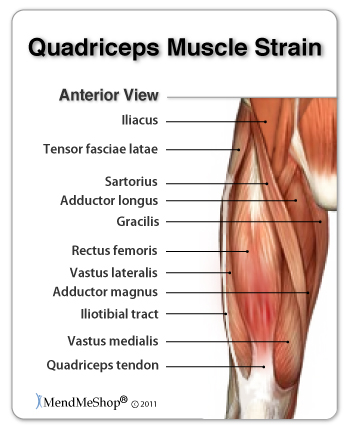
Quadricep Anatomy
The bones involved with your upper leg are your thighbone (femur), kneecap (patella) and shinbone (tibia).

The upper leg muscles provide your knees with mobility (extension, flexion and rotation) and strength. Your quadriceps muscles are located on the front of your thigh and extend down to just below your kneecap. They work closely with your hamstring muscles (back of your thigh), your gluteal muscles, and your calf muscles to ensure proper movement of your leg, knee and hip.
Quadriceps are considered knee extensors that transmit a pulling force on your muscle which help you straighten and extend your knee, as seen in kicking motions. Your rectus femoris is the longest quadriceps muscle; it connects your hip and knee joint and is also considered a hip flexor. It starts from the iliac crest of your pelvis, and runs down the front of your thigh attaching to the top of the kneecap via the quadriceps femoris tendon. Your vastus medialis, vastus intermedius (lies under the rectus femoris) and vastus lateralis attach to the top of your thighbone and extend down to your kneecap.
They connect via your quadriceps tendon (tough fibers that connect muscle to bone) and patellar retinaculum (fibrous band-like membrane that extends from the tendons of your vastus lateralis and vastus medialis and attaches to the sides of your kneecap). Your quadriceps tendon then passes over your kneecap (patella), connects to your patellar tendon and inserts into the tibial tuberosity (bump) on the front of your shin just below your knee. These tendons and the patellar retinaculum help to stabilize your knee; as your quads contract (shorten), your tendons help to move your knee from a bent (flexed) position to a straight (extended) position; when your quads relax, they lengthen and move your knee from a straight to a bent position.
Your sartorius muscle is a rotator of the tibia that works with your quadriceps to help straighten your knee and flex the hip. Your quadriceps muscles are innervated by your femoral nerve and artery; there is a lot of connective tissues and fascia around the quadriceps attachments.
Quadriceps Strains
In Latin quadriceps means “four heads” or four muscles. They are long muscles and are therefore more prone to injury. Quadriceps strains (also called pulled quadriceps) are one of the most common injuries in vigorous sports activities. These occur when one or more quadriceps muscles are stretched beyond their limit or are in a vulnerable position, and the muscle tissues become strained or torn. The rectus femoris muscle is the most frequently injured, as it crosses 2 joints (hip and knee), it is rarely completely stretched and it is closest to the surface of the skin. Tears or major damage normally occur at the point where your quadriceps muscles and tendons meet (musculotendinous junction in the quadriceps tendon just above the kneecap – Runner’s knee, or in the patellar tendon just below the kneecap Jumper’s knee). However, they can also occur at any place along your quadriceps muscle bellies, or at the tendon attachments to the bone (generally the pelvis attachment).
Acute strains are caused by a direct hit, fall or overloading, whereas chronic strains are generally caused by overuse or prior unhealed injuries. The damage can range from overstretching to partial tearing to complete rupturing of the small fibers that make up your quadriceps muscles.
These injuries occur most often early in the activity as a result of a poor warm up, or in the later stages of practices or games as a result of fatigue and improper cool downs. It is important to recognize that quadriceps injuries are easy to mask; you may only notice them when you are running quickly or kicking far distances.

Quadriceps strains tend to affect older athletes between 30 – 60 years old, who tend to be weekend warriors (active on weekends, but not during the week). Men are twice as likely to be injured compared to women. You will often experience referred pain from your hip joint, sacroiliac/pelvic joint, lumbar spine and nerves.
If quadriceps strains are not cared for properly these injuries can become chronic and carry on for long periods of time. They can definitely affect your ability to quickly accelerate and decelerate, and cause a lot of inflammation at their attachment to the bone. They will often lead to complete quadriceps muscle and/or tendon tears. Men over 65 years of age or male athletes between 15 – 40 years most often experience a ruptured quadriceps.
Other common quadriceps injuries involve quadriceps contusions caused by a direct hit to the muscle (bruising or hemorrhaging beneath unbroken skin), quadriceps tendonitis or tendinopathy caused by degeneration of the tendons, or avulsion fractures (a severely pulled quadricep will tear a piece of bone with it; this generally occurs where the quadriceps tendon attaches to the patella).
Weak, tight quadriceps muscles also play a role in knee injuries (affect kneecap alignment and knee extension causing strain or damage to ligament or tendon, for example Runner’s Knee) or low back injuries (cause your pelvis to tilt forward creating a sway back). If you allow quadriceps injuries to persist they can lead to repeated damage that is more severe, periostitis (inflammation of the periosteum), and prolonged disability.
Alternate names and/or associated conditions:
Quadriceps pull, strained quadriceps, quadriceps tendonitis, quadriceps tendinopathy, quadriceps tear, quadriceps muscle contusion, Charlie horse, quad injury, runner’s knee, jumper’s knee, avulsion injury, anterior femoral muscle strain, periostitis, quadriceps scar tissue, knee injury pain, compartment syndrome, Myositis Ossificans